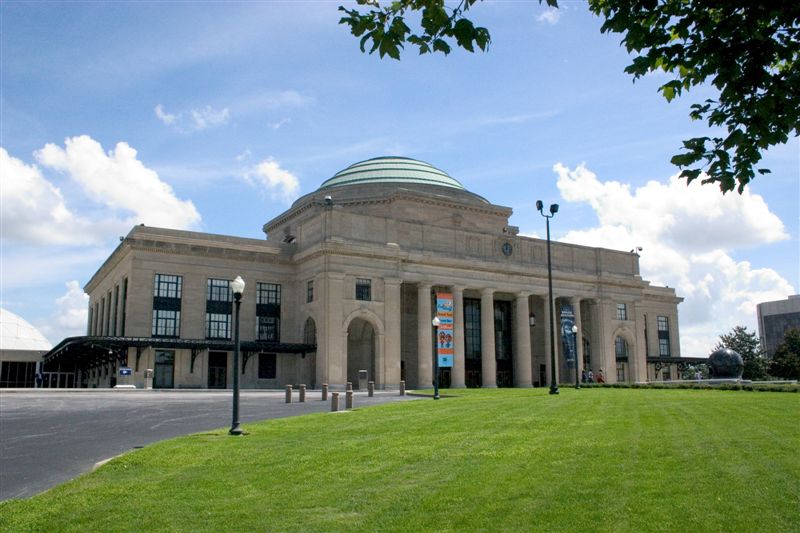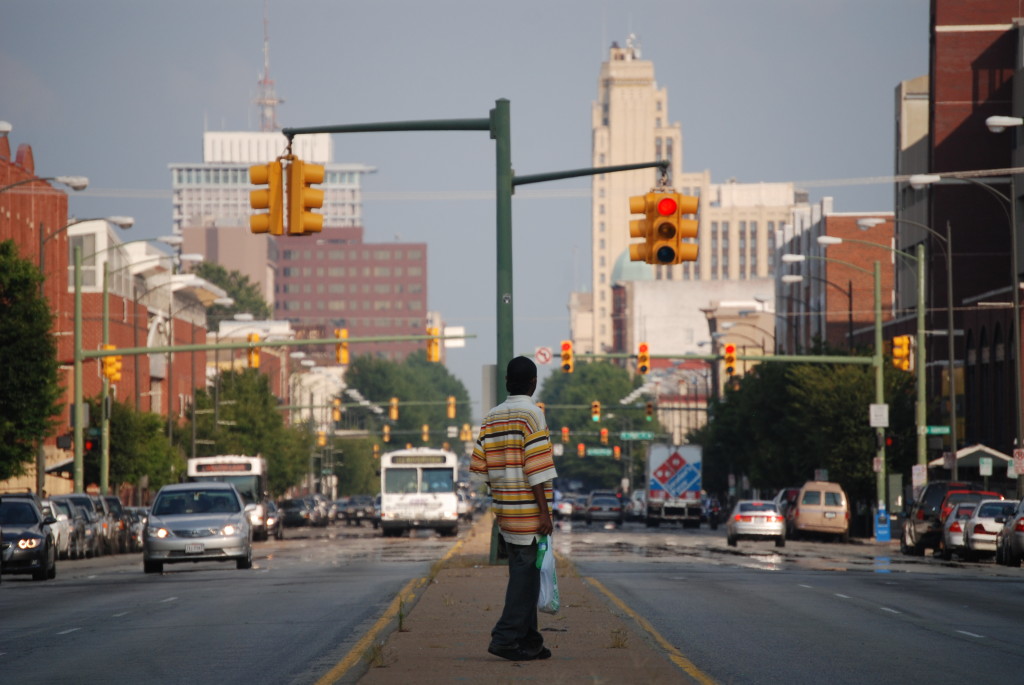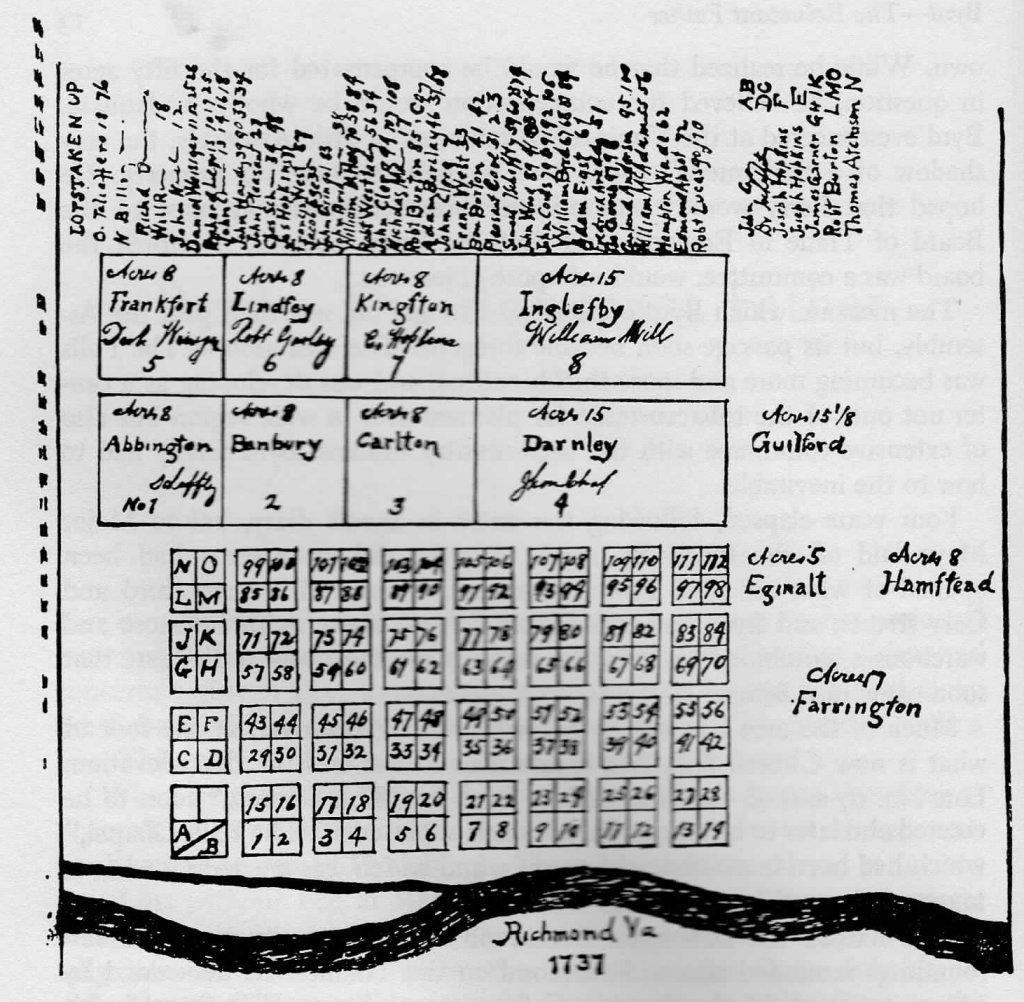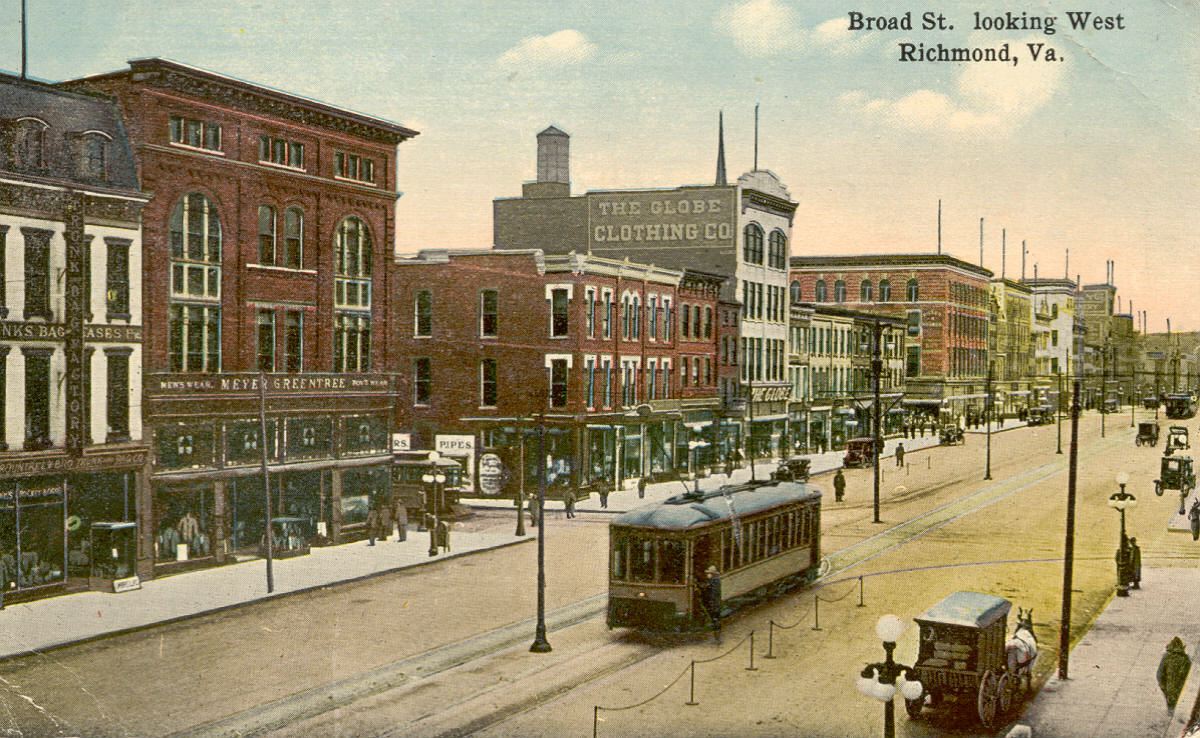When you come into Richmond, you will probably be driving on Broad Street. It is the main East-West thoroughfare in Richmond.
Broad Street use to be known as Richmond Road. It is a part of US Route 250 which stretches from Sandusky, Ohio to Richmond, Virginia. It passes through West Virginia, passes through Charlottesville, and ends in the Eastern-most part of Richmond. The Virginia portion roughly follows the old “Three Chopped Road” Native trail (so named because the path was marked by 3 notches at various points).
The focus today, however, is Broad Street as it relates to Richmond. It has long been the main entry and exit road in Richmond and has represented many things over the City’s history.
When Richmond was first laid out by Major William Mayo and William Byrd II, Broad Street was the northern most boundary in the City.
In fact, early Richmond Historian Samuel Mordecai called anything North of Broad Street the “non-tax paying side of Broad St.” since it was in Henrico County and didn’t have to pay City taxes.
The center of trade and commerce throughout the 18th and most of the 19th Centuries were closer to the river and centered around Main Street and Shockoe Bottom (downtown). Broad Street was referred to as the “upper country.” To get from downtown to Broad Street was not as easy as it was today. There were several ditches and gullies on the hill from the Bottom to the top. Richmond was not always as well laid out as it is today. The city was hilly, rocky, craggy, and an all together rough terrain. Mordecai says that the only way up to Broad from Main was to cut across Capital Square.
Along Broad Street during these times would have been few buildings. It was mainly a thoroughfare for traders. The Street being Broader than a typical Street (thus the name…) it would have much better accommodated trading wagons. Despite this, most of the city’s merchants wouldn’t have set up shop on Broad Street, but rather where goods came in via the river. The land-traversing traders and their wagons would have to go downtown to offload their wares.
As far as buildings, there would have been a few lots owned by wealthy people North of Broad Street (the Wickham House, Brockenbrough House, etc.). The Original Richmond City Hall (built in 1818-1819) was on Broad Street; as well as several Churches.
A Railroad Thoroughfare
In 1836 the Richmond-Fredericksburg, and Potomac Railroad was built and ran directly through Broad Street. Its terminus was at Broad Street and 8th street.
The railroad was not a favorite of travelers. The road was much higher than Broad Street and according to Virginious Dabney’s immortal “Richmond: Story of a City” passenger cars landed in the middle of the street and would be pelted by pebbles flying off of hack wagons, sun, rain, and other displeasing elements.
These conditions were so bad, that one day in 1873 a train rumbling down Broad Street frightened a horse who ran away and one of the cars killed a passenger. This led to a near riot as citizens threatened to harm any RF&P railroad engineer who came and tried to bust up their crowd of protesters. The city shut down rail traffic on Broad and later opened it up so that only horses could pull the train along Broad Street. Those tracks and station remained until the mid-1890s when it moved it’s terminus to the new suburban station farther down Broad Street; named “Broad Street Station” (now the Science Museum of Virginia).

The Science Museum of Virginia, Richmond. Formerly Union Station of Richmond; also known as Broad Street Station. by David Bjorgen
Shopping Hub
Starting in the late-19th and early 20th Centuries, Broad Street became a shopping hub. At one point, it was considered the retail center of the South-East. It housed establishments like the locally based Tallheimers, Miller & Roads, Woolworths, Sears, Cohen’s, and others. It was basically the Short Pump of it’s day. Many of the people with money at this point lived on the western side of town (the result of white flight).
Since this heyday took place during the Jim Crow era where the city was segregated, African Americans were not allowed to shop at stores such as Tallheimers. On 1960 a group of students called “The Richmond 34” staged a sit in inside of the store which inspired protests, which eventually led to integration of the store.
In these store windows, there were mannequins in various states of dress. In 1906, Mayor Carlton McCarthy went on a crusade to make sure that all of the mannequins in the store windows were completely covered up lest they cause anybody to have “unpure” thoughts; and that no female mannequins should be shown in their “unmentionables.”
Theater Row
Also in the late 19th/early 20th Century, Broad Street had a number of theaters. You can still see a few of them today. The National, which is now a music venue, The Carpenter (formerly Lowes Theater), the Capitol Theater building (now offices).
A Symbolic Dividing Line
Broad Street has also been a symbolic dividing line in the City. Traditionally it has separated Rich from Poor and African-American from White.
For most of the 18th and 19th Centuries, this was very apparent in Church Hill. South of Broad, Church Hill was a lot of the old money types, where as North of Broad was new money. This was illustrated (and still is) by the type of materials use for construction. South of Broad buildings are almost exclusively made of a brick; a more expensive and durable material. North of Broad, most of the houses are made of wood and were built by middle class merchants and tradesmen.
Downtown, during the Jim Crow era in Richmond, the thoroughfare divided the traditionally white part of town from the traditionally African American part of town North of Broad. If you go to downtown Richmond now, and visit what is traditionally Jackson Ward (a notable African-American neighborhood until the mid-20th century, you’ll notice that it is all located North of Broad Street.
It also once divided propriety from impropriety. According to Dabney’s tome on Richmond, the shops were all on the South side of Broad Street where it was assumed that the women would be walking an the buildings would shade the sun. The bars, however, were on the North side of Broad St. where the sun would hit them and subject the men in the bars to the uncomfortable heat.

A view looking East on Broad Street at VCU. Photo by Jeff Auth https://en.wikipedia.org/wiki/File:VCU_East_on_Broad_by_Jeff_Auth.jpg
Broad Street Today
Eventually, as most things in Richmond, in the decades up to the new millennium it was a shell of its former self. Largely run down. The great houses of Church Hill were not being well maintained, downtown, departments stores had shuttered and theaters closed. Today, after 20 or so years of revitalization efforts (and a whole lot of money spent by VCU), Broad Street is once again a bustling place.
There are several great restaurants and cafes: Tarrant’s Cafe, Proper Pie Co., Nick’s produce (best sandwich in town) to name a very few.

First Fridays Art Walk
There are several shops and small art galleries. In fact on the first Friday of every month, downtown Broad Street hosts First Fridays. An art walk in the “Arts District” of Richmond on Broad Street where all of the small galleries open up and sell their wares to art enthusiasts.


